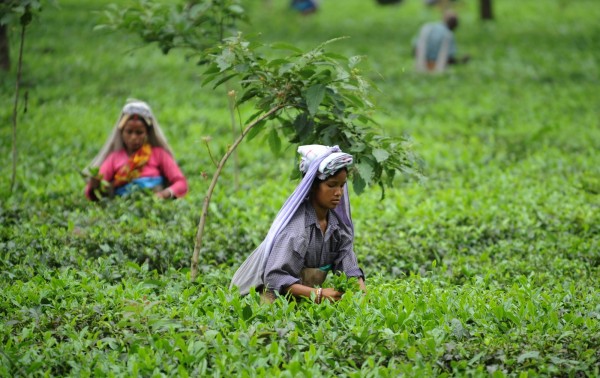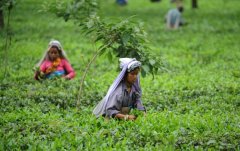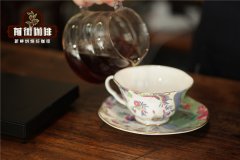What are the flavor characteristics of Darjeeling, Assam, Qimen and Ceylon black tea?
The characteristics of Darjeeling, Assam, Qimen and Ceylon
When many people go to coffee shops, teahouses and restaurants to taste black tea, even if they can understand the name of black tea listed on the menu, they have no idea about its taste, aroma or even its compatibility with food. Not only that, the waiter will then ask, "would you like milk or lemon?" "generally speaking, people who don't know anything about black tea have no answer at all.

Here we will introduce several common representative black teas and their characteristics. I hope that when you order food in the future, you will not be timid because you do not understand, and you can confidently choose the right black tea.
Darjeeling Black Tea (Darjeeling)
Darjeeling is located in a highland about 2300 meters above sea level in the northern province of West Bengal, India. in the late 19th century, green tea seeds and seedlings from China's Fujian Province were planted and later improved into black tea. Darjeeling is located in the Himalayas, coupled with the influence of low temperature, the black tea here can be harvested three times a year, and each has different flavors.
1. Spring picking (First Flush)
Every year, the first pick of Darjeeling black tea, the harvest time is about the first ten days of March to April, revealing the arrival of spring in the Himalayas. The revenue is very small, so the market price is high. The shape of the tea belongs to the OP grade, and there are many silver-white buds called "Silver Tips" in the green tea tone. With aromas of musk grape and champagne, strong astringency and light brown color, it is suitable for drinking alone.
two。 Summer pick (Second Flush)
The harvest period is from May to the end of June, with three major elements of taste, aroma and brown, also known as black tea in early summer. It has the aroma of musk grape, with a strong astringent taste and orange brown. The best way to taste is to drink alone in the first cup and milk in the second.
ClosePowered by GliaStudio
3. Autumn picking (Autumnal Flush)
Darjeeling, which is harvested in autumn, is the last black tea to be harvested every year, and the harvest period is from October to November. The aroma of ripe fruit retains the unique grass-green flavor of green tea. The dark red brown has a strong and strong astringent taste, which is suitable for drinking with milk.
Assam Black Tea (Assam)
Assam is located in the vast plains of northeastern India, with the geographical environment of the Himalayas and the Brahmaputra River (Brahmaputra River). More than half of India's black tea is produced here, and most of it belongs to CTC processing tea, which is most commonly used by Indians to brew spicy tea.
Assam black tea has a strong and deep taste, with a deep astringent taste, pure aroma, dark red and opaque brown color. Suitable for pairing with milk, most commonly used to make milk tea or spice tea.
Keemun Black Tea (Keemun)
The representative black tea in China, along with Darjeeling and Wuba of Sri Lanka, is listed as the "three largest tea teas in the world". Qimen, located in Anhui Province in southeastern China, has a subtropical climate. Although the annual average temperature is very high, it rains about 200 days a year because it is located in the mountains and has a large temperature difference between day and night. This climate is very suitable for growing black tea, which has completely different flavor characteristics from Indian and Sri Lankan black tea.
Keemun Black Tea has a moderate astringent taste and a deep and rich taste. The aroma is sweet and greasy with caramel, like chrysanthemums or ripe persimmons, pears, apples and so on. The brown color is dark red with a touch of purple.
Unique personality is also popular in the UK, whether drinking alone or with milk.
Ceylon black tea (Ceylon)
Ceylon became independent from the British colony in 1948 and changed its name to "Sri Lanka" in 1972. After that, the black tea produced here became Sri Lankan black tea, but it is still commonly known as Ceylon black tea. Ceylon black tea is divided into six producing areas according to the elevation of the planting area, which has its own unique personality and characteristics under the influence of different climate, wind, fog and sunshine.
1. Nuvale Ariel (Nuwara Eliya)
The taste is refreshing, with a smooth astringent taste. Grassy aromas with sweet aromas of fruit. The brown is light orange, suitable for drinking alone.
two。 Udapu Serawa (Uda Pussellawa)
The taste is similar to Nuvale Ariel black tea, with a strong and refreshing astringent taste. Affected by the monsoon from January to February each year, the aroma and flavor are stronger than those in other producing areas, with mint-like aromas. The brown color varies with the way the tea is made, and it is generally a clear orange. It is not only suitable for drinking alone, but also delicious with milk.
3. Uba (Uva)
One of the three largest teas in the world. Uba facing the Bay of Bengal is affected by the monsoon in July and August, and the black tea has a refreshing mint aroma, as well as the smell of mangosteen and green apple. Wuba black tea is mostly astringent and dark red, which is suitable for drinking milk tea with milk.
4. Tinpra (Dimbula)
Sri Lanka's representative black tea has three major elements: taste, aroma and brown.
Under the blowing of the monsoon in January and February, it has achieved a strong personality of the tea season (Quality Season, the season with the best tea quality of the year). The rose-like flowers are mixed with the aromas of fresh green leaves, and the dark orange-red brown is suitable for drinking alone or with milk.
5. Kenya (Kandy)
Kenya is the birthplace of Ceylon black tea, most of which are planted at low elevations of 400 to 600 meters. The smooth taste and aroma are the most important features of Kenya black tea. The brown color is red and clear, which is suitable for making iced tea and black tea with various flavors.
6. Hanna Lou (Ruhuna)
The lowest altitude black tea producing area in Sri Lanka, affected by the southern climate, the tea grows well and the leaf shape is larger. As the high temperature accelerates the fermentation, the black tea brewed has a strong astringent taste. The aroma is as sweet as honey and caramel, dark red in brown. Can be drunk alone, especially with milk, it is recommended to try to make milk tea.
The Tea Man of Sri Lanka
The difference between black tea and green tea
The first tea introduced into Europe in the early 17th century was Chinese green tea and Fujian Province's Zhengshan race black tea, both of which were green and black respectively.
After brewing, green tea shows a light yellowish green, black tea is dark dark red, the difference between the two is more obvious, as easy to understand as black pepper and white pepper. Because of the great difference, people even mistakenly think that they are two completely different plants. Recently, black tea has also been grown in Japan, and tea farmers will produce both green tea and black tea, so people have come to understand that these two kinds of tea actually come from the same kind of tea tree.
Tea tree belongs to the family Theaceae, whose scientific name is "Camellia sinensis". "Camellia sinensis" is divided into two species, one is a small leaf species with smaller leaves, which is called "Chinese species". Large leaves are large leaf species, mostly found in Yunnan, Sichuan and other places in China, as well as subtropical areas such as Myanmar and India, also known as "Assam species".
The leaves of Chinese tea trees are about two fingers wide and are widely planted in southeastern China. Green tea, including Japan, is also from Chinese species, so it is more familiar to Chinese and Japanese. Assam's tea tree is known as "Camellia sinensis var assamica", and the larger leaves can even grow as big as the palm of the hand. The difference between the two can be easily understood by comparing small tomatoes with large tomatoes. Although the two kinds of tomatoes taste the same, they are all different in terms of pulp or juice content and cooking methods.
To sum up the above, green tea is mainly Chinese, while black tea is mostly Assam, both of which are tea trees, both of which can be used to make green and black tea.
After picking off the green leaves, they will immediately be heated by steaming or stir-frying to retain the original green of the leaves. After kneading and drying, they will become green tea.
On the other hand, black tea is made by withering the picked leaves to volatilize its water, and then by kneading and destroying the tea fiber to produce leaf juice and oxygen to produce fermentation. For example, after grinding the apple into mud and standing for dozens of minutes, the puree will turn red and finally turn brown. The same is true of black tea, which changes the tea from green to brown and brown, and finally blocks fermentation by drying at a low temperature below 100 degrees to become black tea.
The black tea made from Assam tea has high content of catechin, strong astringency and full flavor. In contrast, black tea made from Chinese tea trees has a weak fermentation effect, tastes less astringent and tastes similar to oolong tea. But also because the astringent taste is light, so it tastes better and can be tasted directly without milk or sugar, which is very suitable for Japanese cuisine.
On the other hand, the producing area of Assam, which mainly produces black tea, has recently been affected by the prevalence of green tea, and some places have begun to use Assam's tea trees to produce green tea for export. Compared with Chinese green tea, this kind of green tea has a deeper taste, a small amount of green tea can make a full flavor, and the brown color is clear and uncloudy, which is well received. As for which kind of tea to choose and how to brew it, it all depends on the individual's use of tea technology.
Why is black tea "black tea" in English?
Although black tea is black, it is called "black tea" in China, because the name "black tea" comes from the brown color of tea. In other words, because the tea is red, it is called "black tea". After black tea spread from China to Japan, the Japanese directly used the original name, so it was also called "black tea".
On the other hand, for Europeans, green tea and brown tea are called "green tea", while black tea brewed with hard water is black compared to red, and the tea itself is also black, so it is called "black tea".
However, the English word "black tea" contains two meanings, one of which refers to drinking alone without milk. Here, it doesn't matter if you add sugar, so it has nothing to do with adding sugar or not. Another layer of meaning refers to black tea itself. Whether it is black tea from China or from India or Sri Lanka, it is called "black tea" in English.
In Japan, drinking alone without milk is generally called "pure black tea" (straight tea), but in Europe and the United States, the word "straight" is mostly used to refer to drinking alcohol such as whisky without water, or with ice, it will inevitably make people feel inappropriate when used in black tea. This means that when you heat sake in Japan, it is called "hot sake" (okannzake), but in other cases such as heated miso soup, the word is not used. If foreigners use "hot miso soup" to refer to heated miso soup, it will also be inappropriate for the Japanese.
Although the Japanese use of "straight tea" is not very appropriate, but because the term "black tea" makes people feel dark and astringent, it is impossible to taste, and it does not sound like a refreshing tea that can be drunk by children or women, so it may be easier for the Japanese to use "straight tea" to describe drinking directly without adding anything.
Incidentally, as mentioned above, "milk tea" is also a Japanese term. Although English also has the term "tea with milk" or "white tea", it is not suitable for men to use.
In Japan, there is even a saying that "royal milk tea" (Royal Milk Tea) is so gorgeous and sounds particularly delicious, but in fact it is also one of the Japanese English. This may be because the word "royal", which refers to the royal family, makes people feel as if they are drinking tea at Buckingham Palace.
For the Japanese, "royal milk tea" refers to black tea with a lot of milk, which is more mellow and higher than ordinary milk tea. in a sense, the name seems to make sense. But in any case, it is the Japanese who drink black tea in Japan, so perhaps there is no need to choose a British-style title.
Important Notice :
前街咖啡 FrontStreet Coffee has moved to new addredd:
FrontStreet Coffee Address: 315,Donghua East Road,GuangZhou
Tel:020 38364473
- Prev

What are the main processes of making tea from tea? Process flow chart of tea-making method
Our common teas are white tea, green tea, black tea and oolong tea. The process of making tea is roughly the same. 1) Chuan Qing: the first step in the production of tea is to use the newly grown buds or noodle leaves on the tea tree as raw materials. (2) Sunlight withering: the green tea leaves are placed outdoors so that part of the moisture disappears naturally from the sun, and the gloss of the leaves disappears into wavy undulation, which is called the soft touch of the hand.
- Next

The temperature of hand-brewed coffee suggests the temperature at which it should be brewed.
Professional coffee knowledge exchange more coffee bean consultation Please follow the coffee workshop (Wechat official account cafe_style) with the arrival of the third wave of coffee, coffee has been transformed from a necessity to a luxury. Coffee lovers pay more attention to the origin, year, manufacture, beans, variety and taste of coffee, which also makes boutique cafes around the world more prosperous.
Related
- Beginners will see the "Coffee pull flower" guide!
- What is the difference between ice blog purified milk and ordinary milk coffee?
- Why is the Philippines the largest producer of crops in Liberia?
- For coffee extraction, should the fine powder be retained?
- How does extracted espresso fill pressed powder? How much strength does it take to press the powder?
- How to make jasmine cold extract coffee? Is the jasmine + latte good?
- Will this little toy really make the coffee taste better? How does Lily Drip affect coffee extraction?
- Will the action of slapping the filter cup also affect coffee extraction?
- What's the difference between powder-to-water ratio and powder-to-liquid ratio?
- What is the Ethiopian local species? What does it have to do with Heirloom native species?

